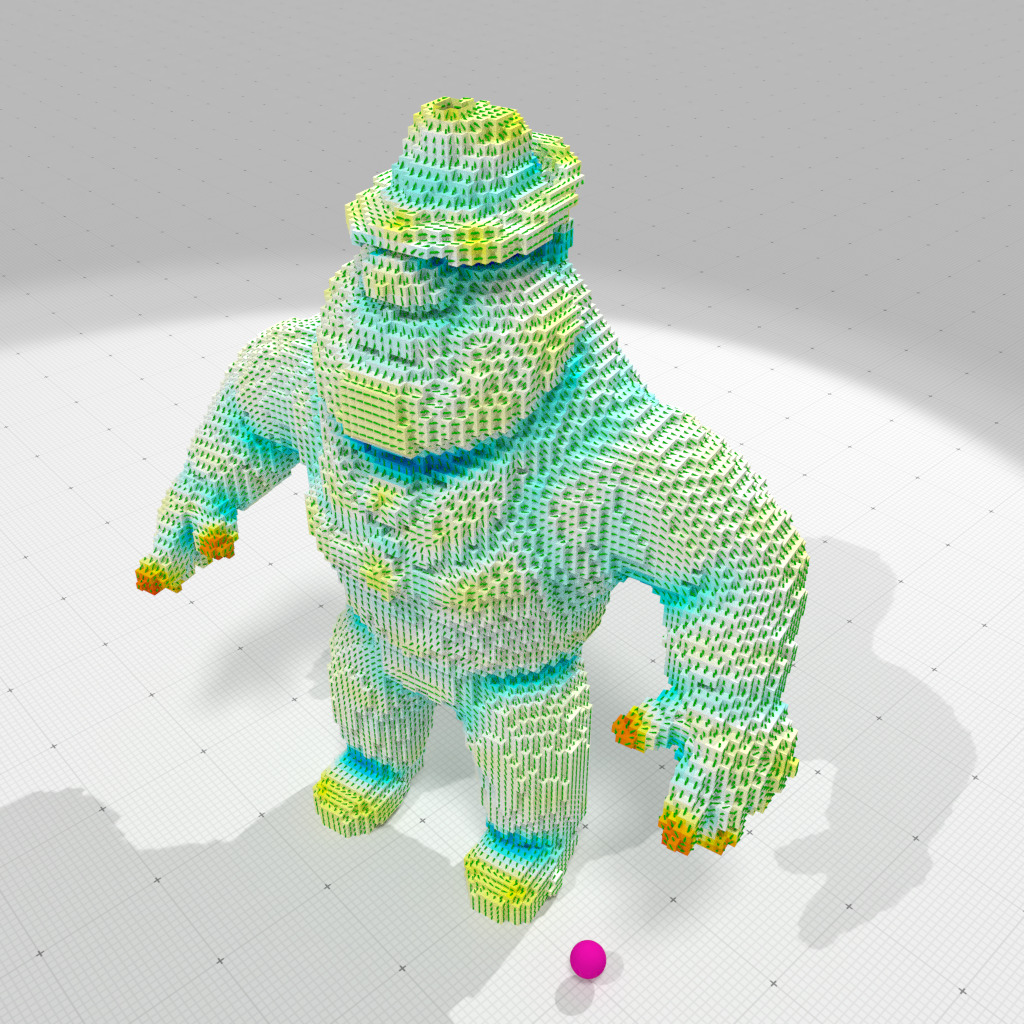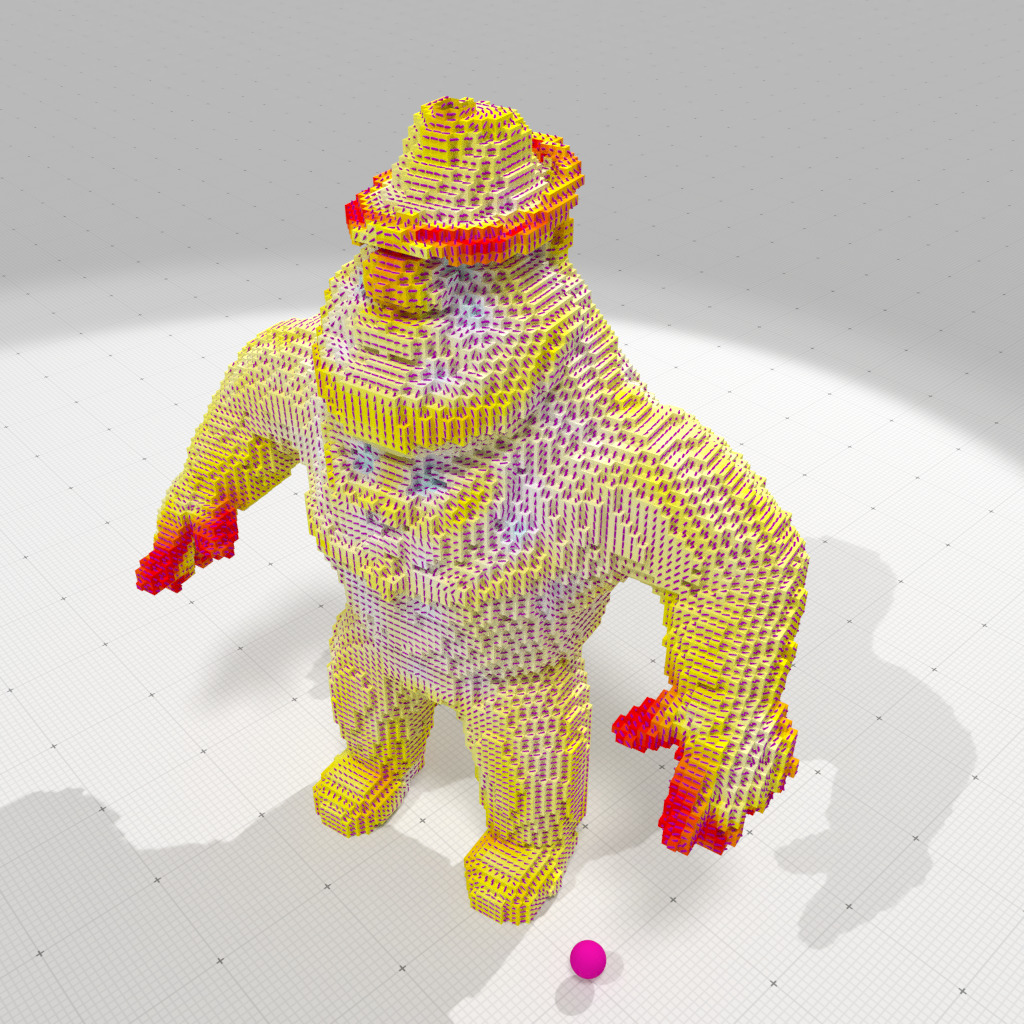Loading...
Searching...
No Matches
geometry/meshes/vol-curvature-measures-icnc-XY-3d.cpp
Computation of principal curvatures and directions on a mesh defined by a VOL digital file, using interpolated corrected curvature measures (based on the theory of corrected normal currents). It uses a digital normal vector estimator to improve curvature estimations.
# "Al" vol file ./examples/geometry/meshes/vol-curvature-measures-icnc-XY-3d ../examples/samples/Al.100.vol 2.0 0 1 0.33
outputs
- Domain size is 100 x 100 x 100 - digital shape has 70413 voxels. - surface has 21239 surfels. [SurfaceMesh (OK) #V=21278 #VN=0 #E=42522 #F=21239 #FN=0 E[IF]=4.00151 E[IV]=3.9968 E[IFE]=1.99793] - CTrivial normal t-ring=3 (discrete) Computed k1 curvatures: min=-0.591355 max=0.332964 Computed k2 curvatures: min=-0.0853815 max=0.559684
It also produces several OBJ files to display curvature estimation results, example-cnc-K1.obj, example-cnc-D1.obj, example-cnc-K2.obj, and example-cnc-D2.obj as well as the associated MTL file.

Interpolated corrected smallest principal curvature and direction, r=2 | 
Interpolated corrected greatest principal curvature and direction, r=2 |
- Note
- In opposition with Normal Cycle curvature measures, (interpolated) corrected curvature measures can take into account an external normal vector field to estimate curvatures with better accuracy.
#include <iostream>
#include <algorithm>
#include "DGtal/base/Common.h"
#include "DGtal/math/linalg/EigenDecomposition.h"
#include "DGtal/shapes/SurfaceMesh.h"
#include "DGtal/geometry/meshes/CorrectedNormalCurrentComputer.h"
#include "DGtal/io/writers/SurfaceMeshWriter.h"
#include "DGtal/io/colormaps/GradientColorMap.h"
#include "DGtal/helpers/Shortcuts.h"
#include "DGtal/helpers/ShortcutsGeometry.h"
#include "DGtal/io/readers/SurfaceMeshReader.h"
#include "DGtal/io/colormaps/GradientColorMap.h"
#include "DGtal/io/colormaps/QuantifiedColorMap.h"
{
DGtal::GradientColorMap< double > gradcmap( min_value, max_value );
gradcmap.addColor( DGtal::Color( 0, 255, 255 ) );
gradcmap.addColor( DGtal::Color( 255, 255, 255 ) );
gradcmap.addColor( DGtal::Color( 255, 255, 0 ) );
gradcmap.addColor( DGtal::Color( 255, 0, 0 ) );
return gradcmap;
}
{
std::cout << "Usage: " << std::endl
<< "\t" << argv[ 0 ] << " <filename.vol> <R> <m> <M> <Kmax>" << std::endl
<< std::endl
<< "Computation of principal curvatures and directions on a vol file, " << std::endl
<< "using interpolated corrected curvature measures (based " << std::endl
<< "on the theory of corrected normal currents)." << std::endl
<< "- builds the surface mesh from file <filename.obj>" << std::endl
<< "- <R> is the radius of the measuring balls." << std::endl
<< "- <m> is the min threshold value for the vol file" << std::endl
<< "- <M> is the max threshold value for the vol file" << std::endl
<< "- <Kmax> gives the colormap range [-Kmax,Kmax] for" << std::endl
<< " the output of principal curvatures estimates" << std::endl
<< "It produces several OBJ files to display principal " << std::endl
<< "curvatures and directions estimations: `example-cnc-K1.obj`" << std::endl
<< "`example-cnc-K2.obj`, `example-cnc-D1.obj`, and" << std::endl
<< "`example-cnc-D2.obj` as well as associated MTL files." << std::endl;
}
{
if ( argc <= 1 )
{
usage( argv );
return 0;
}
using namespace DGtal;
using namespace DGtal::Z3i;
// VOL file
std::string input = argv[ 1 ];
const double R = argc > 2 ? atof( argv[ 2 ] ) : 2.0; // radius of measuring ball
const int m = argc > 3 ? atoi( argv[ 3 ] ) : 0; // min threshold
const int M = argc > 4 ? atoi( argv[ 4 ] ) : 1; // max threshold
const double Kmax = argc > 5 ? atof( argv[ 5 ] ) : 0.33; // range mean curvature colormap
// Read VOL file and build digital surface
auto params = SH::defaultParameters() | SHG::defaultParameters();
params( "thresholdMin", m )( "thresholdMax", M )( "closed", 1);
params( "t-ring", 3 )( "surfaceTraversal", "Default" );
auto bimage = SH::makeBinaryImage( input.c_str(), params );
if ( bimage == nullptr )
{
return 1;
}
auto sembedder = SH::getSCellEmbedder( K );
auto embedder = SH::getCellEmbedder( K );
auto surfels = SH::getSurfelRange( surface, params );
SM smesh;
std::vector< SM::Vertices > faces;
SH::Cell2Index c2i;
auto pointels = SH::getPointelRange( c2i, surface );
auto vertices = SH::RealPoints( pointels.size() );
std::transform( pointels.cbegin(), pointels.cend(), vertices.begin(),
[&] (const SH::Cell& c) { return embedder( c ); } );
{
SM::Vertices face;
for ( auto&& primal_vtx : primal_surfel_vtcs )
face.push_back( c2i[ primal_vtx ] );
faces.push_back( face );
}
faces.cbegin(), faces.cend() );
trace.info() << smesh << std::endl;
// Builds a CorrectedNormalCurrentComputer object onto the SurfaceMesh object
CNC cnc( smesh );
// Estimates normal vectors using Convolved Trivial Normal estimator
auto face_normals = SHG::getCTrivialNormalVectors( surface, surfels, params );
smesh.setFaceNormals( face_normals.cbegin(), face_normals.cend() );
if ( smesh.vertexNormals().empty() )
smesh.computeVertexNormalsFromFaceNormals();
// computes area, anisotropic XY curvature measures
auto mu0 = cnc.computeMu0();
auto muXY = cnc.computeMuXY();
// estimates principal curvatures (K1,K2) and directions (D1,D2) by
// measure normalization.
std::vector< double > K1( smesh.nbFaces() );
std::vector< double > K2( smesh.nbFaces() );
std::vector< RealVector > D1( smesh.nbFaces() );
std::vector< RealVector > D2( smesh.nbFaces() );
for ( size_t f = 0; f < smesh.nbFaces(); ++f )
{
const auto b = smesh.faceCentroid( f );
const auto N = smesh.faceNormals()[ f ];
const auto area = mu0 .measure( b, R, f );
const auto M2 = muXY.measure( b, R, f );
std::tie( K1[ f ], K2[ f ], D1[ f ], D2[ f ] )
= cnc.principalCurvatures( area, M2, N );
}
auto K1_min_max = std::minmax_element( K1.cbegin(), K1.cend() );
std::cout << "Computed k1 curvatures:"
<< " min=" << *K1_min_max.first << " max=" << *K1_min_max.second
<< std::endl;
std::cout << "Computed k2 curvatures:"
<< " min=" << *K2_min_max.first << " max=" << *K2_min_max.second
<< std::endl;
// Remove normals for better blocky display.
smesh.vertexNormals() = SH::RealVectors();
smesh.faceNormals() = SH::RealVectors();
auto colorsK1 = SMW::Colors( smesh.nbFaces() );
auto colorsK2 = SMW::Colors( smesh.nbFaces() );
for ( size_t i = 0; i < smesh.nbFaces(); i++ )
{
colorsK1[ i ] = colormapK1( K1[ i ] );
colorsK2[ i ] = colormapK2( K2[ i ] );
}
SMW::writeOBJ( "example-cnc-K1", smesh, colorsK1 );
SMW::writeOBJ( "example-cnc-K2", smesh, colorsK2 );
const auto avg_e = smesh.averageEdgeLength();
SH::RealPoints positions( smesh.nbFaces() );
for ( size_t f = 0; f < positions.size(); ++f )
{
D1[ f ] *= smesh.localWindow( f );
positions[ f ] = smesh.faceCentroid( f ) - 0.5 * D1[ f ];
}
SH::saveVectorFieldOBJ( positions, D1, 0.05 * avg_e, SH::Colors(),
"example-cnc-D1",
SH::Color::Black, SH::Color( 0, 128, 0 ) );
for ( size_t f = 0; f < positions.size(); ++f )
{
D2[ f ] *= smesh.localWindow( f );
positions[ f ] = smesh.faceCentroid( f ) - 0.5 * D2[ f ];
}
SH::saveVectorFieldOBJ( positions, D2, 0.05 * avg_e, SH::Colors(),
"example-cnc-D2",
SH::Color::Black, SH::Color(128, 0,128 ) );
return 0;
}
Aim: This class template may be used to (linearly) convert scalar values in a given range into a colo...
Definition GradientColorMap.h:120
void addColor(const Color &color)
DGtal::GradientColorMap< double > makeColorMap(double min_value, double max_value)
[curvature-comparator-Includes]
Definition curvature-comparator-ii-cnc-3d.cpp:89
Z3i this namespace gathers the standard of types for 3D imagery.
DGtal is the top-level namespace which contains all DGtal functions and types.
Definition ClosedIntegerHalfPlane.h:49
QuantifiedColorMap< TColorMap > makeQuantifiedColorMap(TColorMap colormap, int nb=50)
Definition QuantifiedColorMap.h:113
Trace trace
std::pair< typename graph_traits< DGtal::DigitalSurface< TDigitalSurfaceContainer > >::vertex_iterator, typename graph_traits< DGtal::DigitalSurface< TDigitalSurfaceContainer > >::vertex_iterator > vertices(const DGtal::DigitalSurface< TDigitalSurfaceContainer > &digSurf)